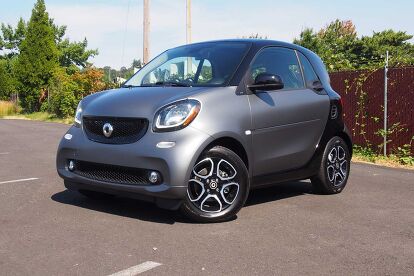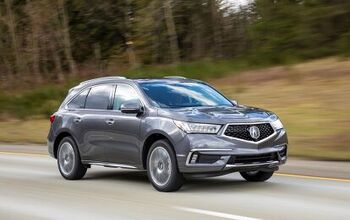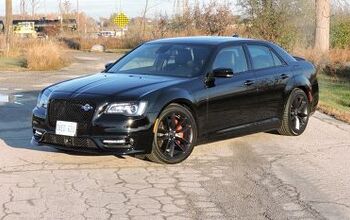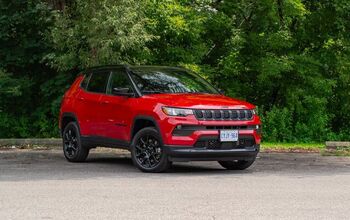2016 Smart Fortwo Review


Daimler’s smart car is a tiny runabout that was designed to offer generous fuel efficiency, youthful quirk and easier maneuverability than a shopping cart.
In theory, it should have been a great success with motorists residing in big cities around the globe, places where tailpipe emissions and limited parking are major issues. Unfortunately, it never really seemed to catch on.
At least in America, the car was largely panned by critics, and for good reason. Driving it the length of a parking space was all it took to realize the smart was a special kind of repugnant. Its half-baked automated manual transmission was rougher than using 60-grit sandpaper in lieu of Charmin. This blunder ruined the vehicle, transforming a potentially useful car into something to be avoided.
But for 2016, Daimler has totally redesigned this vehicle. Company representatives say it offers more space, refinement and standard equipment, all in a package that’s even more maneuverable than it was before. That all sounds promising, but did they actually get the execution right this time?
Same Length, Broader Shoulders
In spite of its brand new styling inside and out, the 2016 fortwo is exactly the same length as its predecessor, a truncated 8.8 feet. But to increase space for occupants and cargo, the car has been widened by nearly four inches.
FAST FACTS
| Engine: | 898-cc turbocharged three-cylinder with 89 hp and 100 lb-ft of torque |
| Transmission: | Six-speed dual-clutch automatic or five-speed manual |
| Fuel Economy: | 33 miles per gallon city, 39 highway, 36 combined |
| Base Price: | $15,400 including $750 in destination charges |
| As-Tested Price: | $19,860 |

Even though it has grown modestly, the new smart’s turning radius is smaller than ever, measuring a tiny 22.8 feet from curb to curb; its predecessor needed more than 28 feet to accomplish the same feat. This makes it incredibly agile in tight places; you can bust a U-turn on all but the narrowest of side streets or alleyways.
Once again, a “Tridion Safety Cell” serves as this machine’s underlying architecture, except this time around, it features hot-stamped, ultra-high-strength steel for maximum protection should the unfortunate occur. Additionally, this structure has been designed for better crash compatibility with larger vehicles.
Just Like a 911

Instead of huffing air the old-fashioned way, this car’s diminutive 898-cc powerlant (yes, it displaces less than one liter) gets boost from an exhaust-driven blower. This helps its trio of lungs breathe a little easier, bolstering output to 89 hp and 100 lb-ft of torque, the latter of which is available at just 2,500 rpm.
These figures may sound pretty modest, but it’s all the power this vehicle needs because at about 2,000 pounds, the fortwo is a featherweight.

Addressing its predecessor’s biggest shortcoming, engineers threw out the previous transmission, hopefully crushing any leftover examples and then lighting their remains on fire along with the blueprints. The old clunky transmission has been replaced with not one, but two options. Drivers can choose between a brand-new twinmatic six-speed dual-clutch unit or a five-speed manual, if three-pedal motoring is preferable (and when isn’t it?). And here’s a fun fact for you: The 2016 smart is the only Mercedes-Benz family vehicle in the U.S. that’s offered with a stick.

While hardly a speed machine, the new smart fortwo’s acceleration is totally adequate. This car should be able to reach mile-a-minute velocity in 10.5 seconds when equipped with the dual-clutch transmission, which will probably account for about 80 percent of sales in America. Should you need another reason to opt for the manual gearbox, models so equipped are nearly half a second quicker to 60 mph.
As for fuel economy, this vehicle should sticker at 33 miles per gallon city and 39 highway, figures that result in a combined score of 36 mpg. Even in mixed, heavy-footed driving, we managed to average more than 38 mpg, which is damn impressive.
It’s What’s Inside That Counts
Along with numerous engineering enhancements, the 2016 fortwo is graced with a totally new interior. It retains the quirky styling its predecessor was known for, but is noticeably more premium if not entirely luxurious. The door panels and portions of the dashboard are constructed of plastics that look reasonably upscale and interesting fabric trim is splashed throughout the cabin.






The design of the center stack is a bit odd, with a floating pod that houses the radio. What makes this strange is that the optional smartphone cradle clips right into the center of the dashboard, where it blocks many other controls. For connected, tech-savvy drivers, the company offers an app called “smart cross connect” that’s available for both iPhone and Android smartphones. It allows you to use the phone like a touchscreen to control the car’s multimedia functions like music and navigation. Unfortunately, the U.S. version of the app is still beta testing, so it was borderline unusable during my drive. Expect smart to work out the glitches before the car arrives at dealers this fall.
The car’s wider body provides significantly more shoulder room, a boon for comfort. Enhancing its versatility, the passenger seat’s backrest can be folded flat for greater cargo-carrying capacity.

As for pricing, the 2016 smart fortwo starts at $15,400, including $750 in delivery charges. That’s a $1,400 increase compared to its predecessor, though supposedly this is offset by about $2,000 in additional standard equipment.
The model I evaluated stickered for $19,680 out the door, which is rather high for such a tiny car. Options that inflated its price included an automatic transmission ($990); the prime trim line, which included things like heated seats, a sunroof and fog lamps ($2,840); a smartphone cradle ($100); and hazel brown metallic paint ($350).
The Drive
Compared to its awful predecessor, the 2016 fortwo drives orders of magnitude better. The transmission has been so thoroughly improved that it’s difficult to describe. Shifts are smooth, prompt and totally livable. After what seems like an eternity, Daimler has at long last exorcised the smart car’s most troublesome demon.
Is this gearbox perfect? Not entirely. On occasion, it will judder at low speeds and sometimes shifts can be rough, but its performance is comparable to other dual-clutch automatics on the market.

Additional suspension travel and tires with taller sidewalls provide a more compliant ride; standard crosswind assist keeps it tracking true, even in blustery conditions. Overall, the fortwo is dramatically more stable at freeway speed, feeling less like a Shriner car and more like a real vehicle.
However, there is one downside to the fortwo’s suspension tuning. It provides more dive and squat than an aerobic workout session; body motions are comically exaggerated during braking and acceleration. The car’s nose pitches downward and its butt dips dramatically, unusual sensations, especially in a modern car.
In the power department, this little runabout feels substantially fleeter than its predecessor. The engine delivers surprising torque, which makes driving in urban settings a snap. Highway jaunts are pleasant enough as well, though there is a touch of wind and tire noise at higher speeds.

Another feather in this smart’s cap is impressive powertrain isolation, a feat that’s particularly notable given that it has an odd number of cylinders pounding away underneath the cargo area. However, the first test car I evaluated had an alarmingly unrefined idle. At tick-over, its engine was choppier than the waters of Nantucket Bay during a nor’easter. Fortunately, this seems to have been an anomaly, as another smart I drove was dramatically more refined.
Also, for such a small car, there are some gigantic blind spots. Rearward visibility at oblique angles is difficult, as the smart’s B-pillars are massive.
The Verdict: 2016 smart fortwo Review

Even with all its improvements, however, this car is probably going to be a tough sell, though not because the vehicle itself has any deal-breaking flaws. Value is a major issue this time around. For the same money, you can get a Chevy Sonic, Ford Fiesta or Honda Fit, “real” cars with backseats, more storage space and normal styling. If uniqueness and easy parking matter, the smart could be for you, but if you need anything else from a vehicle, you’re better off looking elsewhere.
The 2016 smart fortwo arrives at dealers in late September.
Discuss this story on our smart Forum
LOVE IT
- Dramatically improved
- Dual-clutch automatic
- Fuel economy
- Torque
LEAVE IT
- Suspension Tuning
- Blind spots
- Pricing

Born and raised in metro Detroit, Craig was steeped in mechanics from childhood. He feels as much at home with a wrench or welding gun in his hand as he does behind the wheel or in front of a camera. Putting his Bachelor's Degree in Journalism to good use, he's always pumping out videos, reviews, and features for AutoGuide.com. When the workday is over, he can be found out driving his fully restored 1936 Ford V8 sedan. Craig has covered the automotive industry full time for more than 10 years and is a member of the Automotive Press Association (APA) and Midwest Automotive Media Association (MAMA).
More by Craig Cole
































































Comments
Join the conversation
Looks like it's time to trade in the 2009. Looks pretty sweet.
Trying to do a thing for my school this is fun my doods and this is a nice are DANK MEMES